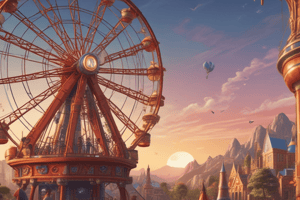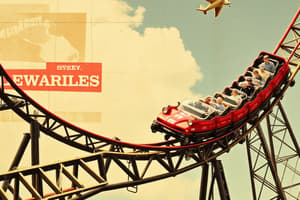Podcast
Questions and Answers
What is the main force that drives roller coasters?
What is the main force that drives roller coasters?
- Gravity (correct)
- Magnetic force
- Friction
- Centrifugal force
What type of energy does a roller coaster have at the highest point of the ride?
What type of energy does a roller coaster have at the highest point of the ride?
- Mechanical energy
- Kinetic energy
- Potential energy (correct)
- Thermal energy
How are roller coaster cars usually pulled to the top of a steep hill?
How are roller coaster cars usually pulled to the top of a steep hill?
- By a lift mechanism (correct)
- Using engine power
- By magnetic force
- By centrifugal force
What happens to the potential energy of a roller coaster at the top of the hill?
What happens to the potential energy of a roller coaster at the top of the hill?
What principle provides the energy and motion for roller coasters?
What principle provides the energy and motion for roller coasters?
What is the stored energy based on the position of a roller coaster at the highest point of the ride?
What is the stored energy based on the position of a roller coaster at the highest point of the ride?
What is the main working force for roller coasters?
What is the main working force for roller coasters?
What provides the energy needed for a roller coaster to complete its course?
What provides the energy needed for a roller coaster to complete its course?
What is the energy of motion called?
What is the energy of motion called?
What type of energy does a roller coaster have when it is released at the top of the hill?
What type of energy does a roller coaster have when it is released at the top of the hill?
What happens to the roller coaster's potential energy as it accelerates down the first hill?
What happens to the roller coaster's potential energy as it accelerates down the first hill?
What is the result of friction between the coaster's wheels and the track?
What is the result of friction between the coaster's wheels and the track?
Why do roller coaster designers make the first hill as tall as possible?
Why do roller coaster designers make the first hill as tall as possible?
What is the main reason for the coaster eventually slowing down and stopping?
What is the main reason for the coaster eventually slowing down and stopping?
What is the term used by some roller coaster enthusiasts to describe the feeling of rising out of their seats?
What is the term used by some roller coaster enthusiasts to describe the feeling of rising out of their seats?
What is the name of the physics law that states energy can only be transformed into other types of energy?
What is the name of the physics law that states energy can only be transformed into other types of energy?
What is the effect of air resistance on the roller coaster's energy?
What is the effect of air resistance on the roller coaster's energy?
What concept do roller coaster designers consider from the field of biology?
What concept do roller coaster designers consider from the field of biology?
What do roller coaster engineers use to reduce friction and ensure a smooth ride?
What do roller coaster engineers use to reduce friction and ensure a smooth ride?
What is the primary factor that controls the riders' experience on a roller coaster?
What is the primary factor that controls the riders' experience on a roller coaster?
Flashcards are hidden until you start studying
Study Notes
Roller Coaster Principles
- The main force that drives roller coasters is gravity.
- At the highest point of the ride, a roller coaster has potential energy.
- Roller coaster cars are usually pulled to the top of a steep hill using a chain lift or a launch system.
- At the top of the hill, the potential energy of a roller coaster is at its maximum.
- The principle that provides the energy and motion for roller coasters is the law of conservation of energy.
- The stored energy based on the position of a roller coaster at the highest point of the ride is potential energy.
- The main working force for roller coasters is gravity.
- The energy needed for a roller coaster to complete its course is provided by the potential energy at the top of the hill.
- The energy of motion is called kinetic energy.
- When released at the top of the hill, a roller coaster has potential energy that is converted to kinetic energy.
- As the roller coaster accelerates down the first hill, its potential energy is converted to kinetic energy.
- The result of friction between the coaster's wheels and the track is heat and a loss of energy.
- Roller coaster designers make the first hill as tall as possible to maximize the potential energy.
- The coaster eventually slows down and stops due to friction and air resistance.
- The term used to describe the feeling of rising out of their seats is "airtime."
- The physics law that states energy can only be transformed into other types of energy is the law of conservation of energy.
- Air resistance has a negative effect on the roller coaster's energy, reducing its speed.
- Roller coaster designers consider the concept of g-force from biology.
- To reduce friction and ensure a smooth ride, roller coaster engineers use lubricants and specialized track materials.
- The primary factor that controls the riders' experience on a roller coaster is the track design.
Studying That Suits You
Use AI to generate personalized quizzes and flashcards to suit your learning preferences.




